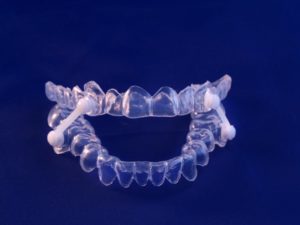 If sleep apnea in Lawton is keeping you from getting a good night’s rest, an oral appliance can be the perfect solution – but only if you wear it. Unfortunately, some patients give up on it early on, finding it too uncomfortable. This is a classic case of giving up too soon; with enough time, you’ll be able to wear your appliance much more comfortably. Here are some common problems patients experience while wearing a new oral appliance – and some tips for making the adjustment process easier!
If sleep apnea in Lawton is keeping you from getting a good night’s rest, an oral appliance can be the perfect solution – but only if you wear it. Unfortunately, some patients give up on it early on, finding it too uncomfortable. This is a classic case of giving up too soon; with enough time, you’ll be able to wear your appliance much more comfortably. Here are some common problems patients experience while wearing a new oral appliance – and some tips for making the adjustment process easier!
The Appliance is Uncomfortable
Pretty much any dental appliance is going to feel uncomfortable at first as your brain and body react to the new, unnatural sensations. The best way to get past this is to wear it consistently for about two weeks; after a while, your brain will start to block out the discomfort.
Your appliance might also feel tight at first, but you can get used to it very quickly. If, however, one or two teeth are sore or otherwise very uncomfortable after a couple of nights, call your dentist; they can make necessary adjustments. (Some patients worry that the tightness means that their teeth will start to move, but that won’t happen with an appliance designed to treat sleep apnea.)
The Appliance Makes Me Gag
Some patients might have a stronger gag reflex than others, but this reaction is partially mental and can be worked on during the adjustment process. To help with this, practice putting your appliance in during the day for short periods of time. Focus on relaxing your body and breathing through your nose. Once you’re used to wearing it during these short sessions, it’ll be easier to start wearing it at night.
The Appliance Makes Me Drool
The mouth is used to primarily receiving food, so when there’s a new object present, naturally a lot of saliva is produced. Like the initial sensations of discomfort, this will go away as the body and brain get used to the new object. Just keep wearing the appliance regularly.
What If It Takes Too Long to Adjust?
If you’ve stuck to the therapy for 2 or 3 weeks and still haven’t adjusted to the appliance, some changes might be needed. The dentist can adjust it so that it’s not as tight or so you won’t bite into it too hard. Sometimes you might need an appliance of a different design; for example, patients who are unable to overcome their gag reflex might get one that only covers some of the front teeth.
Always remember that while an appliance might feel strange and inconvenient at first, the condition it’s treating – sleep apnea – is far worse for your health. With oral appliance therapy, you’ll be able to enjoy a good night’s sleep once again.
About the Author
Dr. David J. Drummond is a Diplomate in the American Sleep and Breathing Academy and has years of experience in helping patients overcome snoring and sleep apnea at his practice, Stop Snoring Lawton. He has many different types of effective, comfortable oral appliances. To schedule an appointment, visit his practice’s website or call (580) 227-8789.

